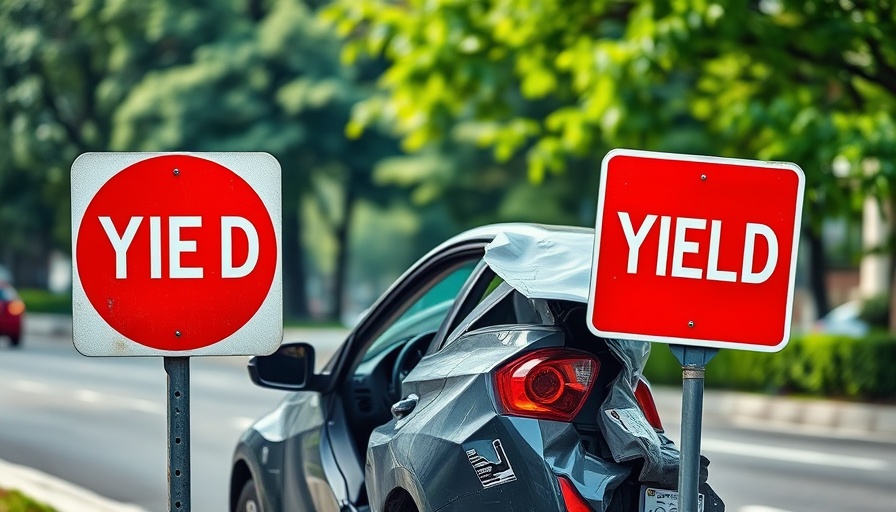
Understanding Fault in Side-Impact Crashes
Side-impact collisions, particularly at yield signs, might seem straightforward, but determining fault can be intricate. In South Carolina, yield signs dictate that drivers must slow down and give way to oncoming traffic before proceeding. However, when this rule is disregarded, accidents frequently occur, resulting in injuries and costly repercussions for those involved. Victims may face financial burdens, medical expenses, and significant disruptions to their lives. If you've found yourself in a similar situation, understanding your rights is essential.
Key Factors to Consider in Yield Sign Accidents
Several elements dictate who is at fault in an accident involving a yield sign. Recognizing them can help victims seek compensation more effectively:
- Right of Way Rules: In these scenarios, the party who disregards the right of way typically bears liability. If you were proceeding while another vehicle failed to yield, you might have a strong claim.
- Speed of Vehicles: The speed at which both vehicles are traveling plays a crucial role. If a driver misjudges traffic speed, this could shift fault towards them.
- Traffic Conditions and Visibility: Poor weather or obstructed visibility does not absolve a driver from responsibility. However, it may influence how fault is determined.
- Road Design: If an intersection is poorly designed or signage is obstructed, local government entities might share liability in an accident.
Proving Fault: The Essential Evidence You Need
To establish that the other driver was at fault, comprehensive evidence is required. Key pieces of evidence include:
- Police Reports: Always file a police report after an accident. This report details the incident and provides critical context that can aid insurance claims.
- Witness Testimonies: Eyewitness accounts can lend support to your claim, especially if they corroborate your version of events.
- Traffic Cam Footage: If the accident occurred at an intersection, traffic cameras may offer visual proof of who had the right of way.
- Photographs: Pictures of the accident scene, damages, and vehicle positions provide compelling evidence of how the crash occurred.
Common Misconceptions About Yield Sign Accidents
Misunderstandings surrounding yield signs and liability are common:
- “Yield Means Stop”: Some drivers interpret yield signs as stopping permanently before proceeding. However, yielding means assessing oncoming traffic and deciding if it's safe to proceed.
- “I Can’t Be Injured Because I Was Yielding”: Even if you were in the right by yielding, you can still suffer injuries from another driver’s negligence.
- “Insurance Will Automatically Cover My Claims”: Insurers often seek to minimize payouts, leading to denials based on misinterpretation of fault. Knowing your rights is crucial here.
Understanding Your Rights Following a Yield Sign Accident
South Carolina residents must understand their rights after being involved in a yield sign accident. You have the right to seek compensation for medical bills, lost wages, and pain and suffering if another driver was at fault. Consulting with a knowledgeable personal injury attorney can make a significant difference in your case.
While insurance companies play a vital role in the recovery process, they often prioritize their bottom line over your well-being. An experienced attorney can advocate for you, ensuring that you receive the financial compensation you deserve.
Staying Informed: A Community Effort to Improve Road Safety
In South Carolina, accidents at yield signs and intersections are a serious concern. Awareness and education about the rules of the road are crucial in preventing accidents. Community safety initiatives aimed at educating drivers about the importance of yielding can go a long way in reducing these accidents.
Staying informed about local traffic trends, accident statistics, and roadway safety updates is essential for all drivers. This knowledge empowers residents to make safe decisions on the road, ultimately protecting themselves and their families.
When involved in an accident that stems from another driver’s negligence, don’t navigate the complexities alone. Reach out to legal experts who can guide you through each step of the claims process and ensure that your rights are protected. For residents in South Carolina, staying aware of accident patterns and preventative measures is not just about individual safety—it's about community well-being.
 Add Row
Add Row  Add
Add 




Write A Comment